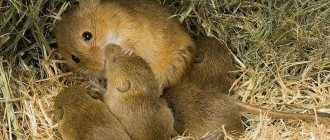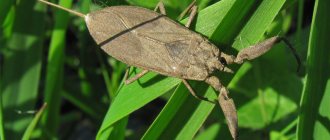How a mole adapted to life underground
Wise nature made sure that the mole could live comfortably underground. The body is oval-shaped, dense, the head is connected to it by a thick neck, the muzzle with a wide forehead is elongated with a narrow stigma - all this helps the mole to move easily and freely underground.
The animal has no eyes as such, only small holes, half-covered by fur. There are underground moles in which they are generally densely overgrown. And an underground dweller does not need vision. But their hearing is well developed, despite the absence of auricles - only special leathery folds protect the ear openings from soil.
Mole - the greatest tunnel digger
The mole's front paws are very similar to small shovels. With them he deftly and quickly rake the ground and dig passages. At the same time, five well-developed fingers in the hand also help in the digging process.
And even wool is a helper for the mole underground. The beautiful, shiny, brown or black coat consists of straight growing hairs. As a result, when moving through underground passages, they lie in the right direction and do not interfere with his movement.
Where does the mole live?
The mole is a dungeon animal. He has poorly developed vision, but is well oriented thanks to his sense of smell and hearing. He prefers familiar depth rather than sun and bright light. If by chance a mole gets to the surface, it backs away and tries to get back into its hole.
The mole on the surface: surprised and discouraged.
Lifestyle Features
Moles are predatory animals. They prefer mollusks, bugs, worms and other small animals. Hungry animals may covet small rodents, and angry animals may covet other moles. That is why their constant search for food does not stop.
This kind of nutrition also ensures the rodent’s lifestyle - it builds itself a special home with a place to rest, supplies and various passages.
Ever seen a live mole?
Never happened
A mole's life underground
The mole is underground all day and night and is on the move almost all the time, digging tunnels. It usually settles in places where the soil is moist and easy to dig. These are forest edges, meadow and floodplain lowlands. They do this work for a reason; they are looking for food, which is why the passages are called feeding passages.
The mole is a frequent visitor to garden plots. He won the strong dislike of gardeners.
They are located shallow, only 5–10 cm underground, but the permanent passages are at a depth of 15–20 cm. He does not have enough strength to lift such a thickness with his head; he has to push out part of the earth after a short distance. It turns out to be a so-called otnorok. It’s easy to see where it will appear: suddenly the soil begins to move slightly, then the loose part rises and grows before our eyes, becoming a mound.
Favorite food is earthworms. They even store them for the winter in their burrow. And so that the worms do not escape and remain alive, but paralyzed, the moles bite off their heads. The pointed teeth of the predator catch both pupae and larvae, as well as adult insects. And even a mouse or a shrew is too tough for him!
If the mole does not find food within 12 hours, it may die.
Tips for summer residents: defeating moles
We learned from an expert how to protect your garden from underground pests and which method of protection is the most effective.
Have you heard the blackbirds sing? I have no doubt they heard and enjoyed it. How do moles dig in your area? If fortune, by an unfortunate chance, turns its back on you, then the sensitive ear of the gardener will catch this “wonderful” sound. And then piles of excavated earth - mole hills - will disfigure your beloved lawn. And let them repeat that a mole on the plot is like a raven in the heights, like a crayfish in the water - an indicator of the purity of the environment, the most “kind” feeling experienced when seeing a mound in the middle of a cucumber bed is annoyance: why did they choose me?!
A cute animal from a Czech cartoon in real life ruins your mood in an instant. Pyramids of earth, erected overnight, and sometimes brazenly, right before our eyes, are the pinnacle of that beautiful city of trenches, tunnels and passages that each mole family digs. And if the soil in the field has dried up, which means the amount of food for moles has decreased, then expect guests to come to you, because you have fertilized the soil, it is fertile, fatty, and there are a lot of all kinds of larvae, worms, bugs and other food in it. By the way, moles do not hibernate, they only go deeper underground, where they wait out the winter in “preserves”: each one stores up to a kilogram of earthworms as live canned food. Such diligence requires serious work: by eating earthworms, larvae and insects, the mole digs up to 20 meters of underground passages in a garden or vegetable garden per day. It’s a shame that in addition to its beauty, the site also suffers biologically. Moles often dig tunnels directly under plants, causing their roots to hang in the air. Such a plant, cut off from nutrition, soon dies.
Humanity has come up with many ways to deal with the hardworking animal. The abundance of anti-mole methods suggests little effectiveness, but still, let’s not give up.
One of the radical methods is as follows. At the very beginning of spring, the perimeter of the area is surrounded underground (vertically) with a special plastic or galvanized mesh made of small cells. The mesh is buried to a depth of 1.2 meters with an exit of 30 centimeters to the outside. Digging to a shallower depth will not give any result. The mesh must be intact, without holes, otherwise the mole will find and certainly use them. The method is very labor-intensive. For example, if you take a plot of 6 acres, then the length of its perimeter will be approximately 100 meters. It will take a lot of effort and time to dig a hundred-meter trench.
An even more radical and inhumane method is killing with rat poison. Yes, he is capable of killing a mole. If the mole eats the poison. But how to get him to eat pickled grain? Craftsmen came up with the idea of using earthworms, cut into pieces and sprinkled with poison, as bait. The worms move for about 20 minutes - this is enough for the mole in the area to smell it, crawl and eat the treat. But I don’t even want to discuss such a knacker’s method, let alone resort to it.
You can get rid of moles, if there are only a few of them, in a simple and accessible way: a fresh mound is dug up right up to the opening in the tunnel, after which the wait begins for the mole to come “to do repairs.” All that remains is to deftly pick up the mole rat with a shovel and carry it over the fence to where far away.
An interesting trap with the philosophical name “Solomon’s trap” was invented by fighters against the mole regime. It looks like a cylinder 40 centimeters long, and the diameter is about the size of a mole hole. Made from galvanized iron or sheet metal. There are hanging doors at both ends of the pipe that only open inward. The Solomon's Trap is placed in a mole tunnel and covered with soil. Now all that remains is to wait for the mole to get into it.
To avoid setting useless traps in holes abandoned by moles, press down the mound with your foot, press down on the ground, and return to it after a couple of days. The Mole will restore this move if he uses it regularly. Set the trap there.
There are a lot of mole repellent units on sale. These are small devices that stick into the soil and produce sounds at low frequencies, extremely unpleasant for moles and inaudible for people. They need to be used correctly and applied not just one, but several pieces per site. If the size of your plot is more than six acres, install repellers in a checkerboard pattern at the operating distance of each (20-25 meters). The device needs to be rearranged from time to time. The mole can get used to the location of the signal point and learn to bypass it.
The method of killing animals using water is not very effective. The water hose is simply inserted into the hole. If there is water in the holes, the mole will not be able to live in them and will move to another place. But what he will choose - a neighboring plot, a field behind a fence, or a familiar place rich in worms 20 centimeters from a flooded hole - is difficult to predict. And the costs of fighting an uncertain outcome are too high. Firstly, you need a lot of water (at least 100-150 liters per mole) to flood all the passages. One bucket of water will only attract earthworms, which are their food, so instead you will only double the problem. Secondly, it is very difficult to completely fill all underground passages (air jams, etc.). And thirdly, moles dig very quickly (up to six meters per hour), so they can dig a passage above the water level and, after everything is absorbed, begin to make holes in your area again.
And finally, the old, ancient methods. They are still used today, which means they help someone:
- We plant plants in the area whose smell moles cannot stand: beans and black beans (the side shoots and tops of legumes can be placed directly in the tunnels). They can be planted in places or along the border of the site. Some flowers - daffodils, decorative onions, imperial hazel grouse and Siberian scilla, marigolds - are also not favored by moles and may scare them away.
- The mole has a very acute sense of touch and smell. With a generous hand, we place rotten fish, herring heads, rags soaked in kerosene, and naphthalene throughout the garden (including in holes). Just keep in mind that a mole can ruin this job, so you need to place the aromas in different points of the underground labyrinth.
- We put special bombs with sulfur smoke into the minks (you will just have to breathe, and the mole may go deeper for a while).
- The next repelling method is based on the fact that the mole has excellent hearing. (By the way, he also has vision, only his eyes are always covered with fur so that earth does not get into them.) So we will influence the hearing: we cut off reeds 1.5-2 meters long and insert one piece into each hole. The plant should protrude 60-80 centimeters above the ground surface. During windy weather, reeds create the effect of “the howling of the wind in a chimney,” which apparently frightens not only people, but also animals defenseless against mysticism. They say that moles disappear in almost a week. And they say they don't come back. Empty bottles stuck into holes at an angle of about 45 degrees work the same way.
- Personally, I used thin-walled aluminum beer cans and plastic bottles mounted on metal sticks. The principle is simple: a metal rod (a piece of reinforcement, a water pipe) is driven deep into the ground (1-1.5 meters), and an empty beer can is placed on it. The wind blows, the can rings and howls, the rod resonates, the sound and vibrations irritate the mole, and he runs away in panic to the neighbors.
But the most reliable remedy against moles, in my experience, is to get a dog. Our dachshund Gavrik so tirelessly and briskly stomps on the “ceiling” of the mole’s apartment that the unfortunate people do not consider such a life to be a life and avoid the area. Moreover, Gavrik has the patience to stand over a dug-up mound, waiting for the “repairman” mole. Of the three underground inhabitants, I saved (and expelled from the dacha village) two; the third, alas, fell victim to our big-eared hunter, who rejects a humane attitude towards our smaller brothers. But with the advent of the dog, and this is a fact, we forgot about the attack. The lawn is in perfect order. And now we are keeping blackbirds away from Gavrik.
Larisa Yaroshevskaya
What does a mole eat?
Moles eat a lot, as they lose a lot of energy when digging. So it turns out to be a vicious circle: you want to eat - you have to dig the ground - while you are digging - you want to eat again. It can only live for 12 hours without food, so it has to go hunting both at night and during the day.
Contrary to popular belief that moles spoil root vegetables such as carrots and potatoes, moles do not. Mouse-like rodents are crop eaters. Because he does not eat plant foods. And this opinion appeared due to the fact that when digging tunnels, the roots of plants are undermined and disturbed, and this is why they die.
Star-nosed mole. It got its name from the unusual structure of its nose.
Settling in gardens and orchards, moles, with their underground passages and numerous mounds, disturb the integrity of the soil. If it is a lawn, it will be difficult to walk through it with a lawn mower, and the beauty of flower beds can be spoiled by dug-up soil.
Harm from a mole
Animal burrows and passages harm plants. But the mole spoils them not by eating them, but by the fact that, as it makes its way, it injures the plants, which may subsequently die. This is where all the harm lies. To preserve the harvest, you can choose the pest protection option that suits you. All of them are described in detail below.
Plants are a safe way to protect your area from moles and other rodents.
Mole traps allow you to catch the pest quickly and easily.
The greenhouse requires protection from moles; they are comfortable there at any time.
Proven methods of controlling moles on the site. Fast and efficient.
Habitat
The habitat of moles is the west of Russia, Siberia and the east of the Urals, or rather, their forests and forest-steppe zones. They choose to live in regions with moist soils that are easy to dig and are rich in what moles eat in the forest and in the areas bordering it. The majority of animals lead an underground lifestyle, making tunnels.
Some animals prefer a terrestrial lifestyle, which allows them to find food without much difficulty. True, due to the structural features of the front legs, designed for tearing up the soil, moles have to move only by crawling on land. Deep twilight and night are the hours when these animals are active.
In the steppe and taiga expanses there is not a sufficient amount of what moles feed on in the forest (due to acidic and dry soils). However, they are occasionally found in these zones, colonizing water meadows and river floodplains covered with bushes.
At what depth do they live?
Still, let's figure out at what depth moles live. The depth of habitat at any time of the year remains almost unchanged - up to 50 cm. It makes no sense for the animal to dig deeper passages because it costs too much energy. After all, at great depths they are no longer able to raise the ceiling of the passage; they have to push the dug up soil with their hind legs to the surface. And the deeper you have to dig, the more problematic it becomes to carry out this titanic work. A deep hole occurs only in one case - when moles arrange a nesting chamber for sleep and rest.
Let's get to know the digger better
The mole is a representative of insectivorous mammals, adapted to a burrowing, underground lifestyle. Depending on the species, the body size of this animal varies from 5 to 20 cm.
A few words should be said about the peculiarity of his fur coat. The mole's pile is short, soft, grows straight and lies freely in different directions, which allows the little animal to move freely underground in any direction.
The animal sets up a nesting chamber at a depth of up to 2 meters and insulates it.
The myth of hibernation
Since in winter, despite their warm coats, moles are forced to go deeper, an erroneous stereotype has formed that they are sleeping.
There are several explanations for this opinion:
- The gardeners have harvested and think that the mole has nothing to eat, so he falls asleep. This is fundamentally wrong. These mammals are predators! Both damaged tubers and roots of garden plants are just “additional losses” as a result of these animals hunting for bugs and worms.
- Those who know that moles are carnivores believe that since with the onset of cold weather these small predators cannot find enough worms or insects, hibernation is their salvation from hunger.
- If a field or garden is covered with a sufficient layer of snow, then a person simply cannot see how the animal makes new moves.
Of course, the mole goes through very difficult times in winter. In order to survive in harsh conditions, he carefully prepares for wintering, thinks through what reserves to make for the cold period and mobilizes all resources.
However, in particularly cold years, not all wintering moles are able to survive until spring.
But frost is not very scary for these animals, because Mother Nature has awarded them with a warm coat that protects them from the cold underground.
The most terrible enemy of a voracious mole is hunger. Lack of supplies is the main reason for the death of these mammals in winter.
Plants that can drive moles out of the area
These options refer to folk methods of getting rid of mammalian pests, but they work no worse than poisons. A pungent and unpleasant odor for the mole is emitted by:
- Garlic.
- Onion.
- Daffodils.
- Marigold.
They should be planted closer to the mole holes. However, scientists have noticed that some individuals manage to push the hated “stinkers” out of their landing sites, thereby destroying them.
In such cases, it is worth trying to use products with essential oils that have a very strong smell. This is pine, lavender. Pieces of fabric are soaked in oil, which are then placed in the passages.
Often, site owners simply pour kerosene, ammonia or turpentine into holes. By the way, if there is a mousecat living in the house, you should “ask” him to retrain. You need to show him the hole in which the mole will move. The cat's instinct will do its job.
Why do moles create tunnels and hills?
Moles create tunnels for two purposes, traveling and feeding. Passing tunnels are pathways between feeding areas and the bottom. Feeding areas are usually marked by clusters of mounds and shallow tunnels. Their goal is to help the mole hunt for its main diet, worms. The mounds or "mole hills" are excess dirt that has been mined by the jetty to create these tunnels.
Social structure and reproduction
Photo: Mole wild animal
Representatives of the mole family reproduce once a year.
However, the number of moles and the breeding season differs among different species:
- The Siberian breeds in June. However, offspring appear only a year later, in the spring. On average, pregnancy lasts about two hundred and seventy days. At one time, the female gives birth to no more than six cubs;
- The Caucasian prefers to mate in February, and moles appear in March. No more than three cubs are produced at a time. The brood becomes independent within forty days after birth. Representatives of this species increase their numbers very quickly, because the offspring appear very deep underground. He is in no danger;
- The European mate in the spring - during March and April. Forty days after meeting the male, the female gives birth to moles - about nine individuals at a time. The weight of one cub, as a rule, does not exceed two grams;
- Blind. It breeds in February; the gestation period for the young is one month. The female gives birth to about five individuals at a time.
Interesting fact: The lifespan of a mole depends on its species. On average, members of the family live from three to five years.
Ways to fight
The easiest way is to fill the mole holes with water. Of course, in this way you can remove the mole from the garden, but only for a couple of hours, until the mole digs a new tunnel next to the flooded one. The second method, more effective than the first, is to put pressure on the mole’s strong sense of smell and drive it out with the help of pungent odors.
We suggest you read: What does a vole eat: in a meadow, forest, steppe or taiga, is it a herbivore or an omnivore?
To do this, you can use kerosene, mothballs, castor oil and even rotten eggs, anything that gives off an unpleasant odor. For example, you can dilute kerosene in one hundred grams of hot water, wet a rag with it and plug all the mole holes that you can find with it.
But the most effective way to drive moles out of the area is with the help of special ultrasonic devices, which can be bought in specialized stores. The essence of the device is simple: it emits ultrasound, which is unpleasant to animals, which is why moles will be forced to leave the area within the shortest possible time. The only disadvantage of this method is its cost, because such devices are by no means cheap.
Video at home “What does a mole do in winter”
Owners of large plots of land on which crops are grown often have problems due to the appearance of moles. Since these animals complicate the growth of cultivated plants in summer and autumn, there is nothing to harm them in winter, but gardeners are interested in whether moles hibernate in winter. In this article we will provide information about how moles overwinter, how they hibernate, what they do in winter, what they eat. Contents
- 1 What is hibernation in moles
- 2 Video at home “What does a mole do in winter”
- 3 How he lives
- 4 What does it eat?
- 5 Video at home “Life activity of the common mole”
From the video you will find out what this animal does during the cold season.
From the video you will learn how this animal lives.
Kinds
There are currently more than 30 different species of moles. The main four types that are quite common are:
- Blind mole (small);
- Caucasian;
- Siberian;
- European.
Because they spend most of their time underground, they have very small eyes and ears that are almost entirely covered in fur. Their most distinctive feature is their powerful paddle-shaped front end with large, thick toenails that they use to dig their tunnels.
Let's take a closer look below:
- Do moths hibernate;
- What helps moles survive in the cold season;
- Are they able to collect supplies for the winter and continue to dig under the snow in search of new food?
Star-nosed
Star-nosed mole The second name for the mole is star-nosed. It differs from its relatives by its unusual nose. The stigma consists of 22 soft processes - tentacles. Thanks to them, the animal gropes for food. The rest of the body structure is similar to the European mole.
- The mole's body is elongated, about 22 cm long.
- The tail is long - 8 cm.
- The coat is thick, soft, silky, black and brown in color.
- There are no auricles.
- Small eyes are not covered by skin.
The starfish swims and dives well. The mole feeds on crustaceans, slugs, earthworms, larvae, and mollusks. In addition to the underground, aquatic lifestyle, it leads a terrestrial one. It can build nests in rotten stumps, hollows of old trees, under leaves. Prefers swampy areas, soil with high humidity. Often found near rivers, lakes, and swamps in the United States.
Wind turbines and scarers
It is worth building several structures on the site that are driven by gusts of wind and at the same time produce sharp sounds.
The downside is that if there is no wind, the moles will happily continue their life activities on the site. Otherwise, with their noise, the devices can scare away not only moles, but also irritate household members and neighbors.
Industrial grade electronic repellers are much more effective. These include the following inventions:
- Top need to. The sound emitter of this compact device does not cause any inconvenience to people and operates over a wide area only from a battery charge.
- Electronic anti-creep. In addition, it will get rid of shrews and mole crickets. Moles will also not put up with the presence of vibrations of different frequencies in the area.
- Ultrasonic devices. These can even scare away snakes. Infrasound changes the vibration frequency and spreads over an area of at least 10 acres. True, such a device is relatively expensive.
Description and features
A huge number of species of various organisms inhabit the water element; most of the planet’s fauna has settled on land. But the world, rich in life, also represents an underground kingdom. And its members are not only small primitive forms: worms, arachnids, insects, their larvae, bacteria and others.
Creatures that spend their days underground also include mammals. Among these creatures one can name a mole . animal has not been studied as thoroughly as we would like. And the reason is in the characteristics of such creatures that inhabit inaccessible areas hidden from human eyes.
These representatives of the fauna are classified as members of the mole family. The physiological details of their appearance prove how well they are adapted to the unusual way of life that is inherent to them, that is, underground. Here, first of all, it would be nice to mention their paws, without which it would be impossible for such creatures to survive in their usual environment.
Moles are not rodents; they dig the ground not with their teeth, but actively using their forelimbs. Therefore, their rounded hands, reminiscent of oars, are quite wide, with palms turned outward. And their widely spaced fingers are equipped with powerful, large claws.
The hind legs are not endowed with enormous strength and dexterity, but mainly serve to rake out soil previously loosened by the forelimbs.
Other features of appearance (they, like those already mentioned, are clearly visible in the photo of the mole ) include: an elongated muzzle, an elongated nose, a short, thin tail. The body of such animals is covered with short fur, so that its length does not interfere with the movement of these creatures along underground paths.
In addition, their fur grows in an unusual way - upward. It is endowed with the property of bending in any direction, which again facilitates unhindered underground movement. The hair tone is usually gray or black-brown.
But there are also exceptions, depending on the variety and some structural features. Albinos are also found among such animals, although very rarely.
Describing the senses of these creatures, it should be noted that these animals are almost blind. Actually, they don’t need good vision. And the small beady eyes of moles are only capable of distinguishing darkness from light.
Their structure is very primitive and unlike the organs of vision of most mammals, and some constituent parts, for example, retinas and lenses, are completely absent. But the eyes of these underground creatures, almost indistinguishable to prying eyes in the thick fur of the animals, are perfectly protected, covered from the ingress of soil particles into them by mobile, often completely retractable eyelids. But the sense of smell and hearing in moles is well developed. And small ears are also protected by skin folds.
In general, the underground world of mammals is very diverse, because quite a few animals that are similar to moles in that they prefer to hide from the dangers of life and the vicissitudes of the climate underground. These include, for example, the shrew - a creature with an elongated muzzle, covered with velvety short fur.
And not all of the mentioned representatives of the animal kingdom necessarily live exclusively and only underground. Yes, they are not there all the time of their existence, but rather they look for shelter by digging holes or finding shelters made by someone else.
Among these are muskrats, which are considered close relatives of moles and are classified in the same family. They are also drawn underground, although they spend half of their existence in water. Living in burrows are, in addition, the well-known foxes and badgers, as well as chipmunks, wild rabbits, a huge number of rodents and many others.
Well, mole, wait a minute!
Moles are a real disaster in the countryside. And if winters are like this one, then calming them down is not an easy task. It must be said that moles have always been the scourge of the fields. Back in 350 AD, the Roman ruler Palladius issued a decree that ordered the use of cats to combat them and field mice in vineyards and artichoke fields. During the time of Catherine II, they recommended the following: “Take garlic and onions, also camphor and powder all together, poke them into the wells where they come out, and plug them tightly, then all underground animals will disappear.” Or: “Take a bunch of green hemp, stick it into the wells and cover it well with earth... When the hemp rots, it creates a great stench, from which every reptile dies or runs away.”
What has not been invented since then to combat garden diggers! Bottles on pins rattle, beans are planted around the site, fish heads are placed in holes, molehills are filled with water.











